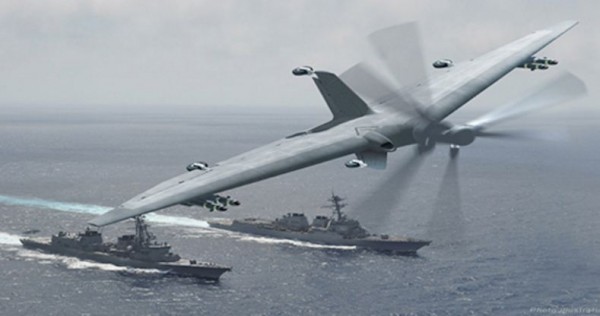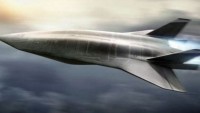DARPA's TERN Drone will Transform US Navy Warships into Aircraft Carriers
| Arthur Dominic Villasanta | | Jun 29, 2016 05:40 AM EDT |
(Photo : Northrop Grumman ) TERN, a long-endurance and armed unmanned air system that will transform forward-deployed small ships of the US Navy into mini-aircraft carriers.
TERN, a new vertical-take-off-and -landing (VTOL) aerial combat drone from the U.S. Defense Advanced Research Projects Agency (DARPA), might be the key weapon that helps validate the U.S. Navy's new warfighting concept called "distributed lethality."
This concept is the Navy's answer to the anti-access, anti-denial (A2/AD) strategies being developed by China and Russia to negate much of the striking power of the Navy's 11 Nimitiz-class nuclear aircraft carriers.
Like Us on Facebook
China's A2/AD strategy in Asia, for example, relies on its much ballyhooed but as yet unproven DF-21D anti-ship ballistic missile (ASBM) to keep Navy carriers outside the disputed South China Sea.
Transforming practically all Navy warships into mini-aircraft carriers will largely invalidate China's and Russia's A2/AD strategies by saturating their defenses with missile-armed aerial drones and kamikaze drones to be launched from different classes of Navy ships and not only carriers.
The only technologically feasible way to transform Navy ships into mini-aircraft carriers is to dispense with a runway. VTOL attack drones will bring about this transformation and the real world iteration of this aircraft is called TERN.
TERN stands for the Tactically Exploited Reconnaissance Node (TERN) program. It's also the name of the VTOL drone that might one day equip Navy warships to help bring about distributed lethality along with other combat drones being developed by DARPA and other contractors.
TERN is a proposed flying wing helicopter powered by two 10 feet long, counter-rotating rotors. This drone is triangular in shape and measures 40 feet on a side.
TERN will initially be designed for reconnaissance missions but will ultimately be turned into a weapons system carrying the Navy's full range of air-to-ground missiles and guided bombs.
TERN envisions using smaller ships as mobile launch and recovery sites for medium-altitude long-endurance (MALE) unmanned aerial vehicles (UAVs). It will make it much easier, quicker and less expensive for the U.S. military to deploy persistent ISR (intelligence, surveillance and reconnaissance) and strike capabilities almost anywhere in the world.
DARPA recently awarded over $110 million to Northrop Grumman that won the program's Phase 3 segment to "design, develop, and demonstrate enabling technologies and system attributes for a medium-altitude long-endurance unmanned air vehicle and shipboard-capable launch and recovery system allowing operations from smaller ships."
Northrop Grumman will use the funding to build a second TERN VTOL aircraft. Phase 3 envisions a tail-sitting, flying-wing aircraft with twin counter-rotating, nose-mounted propellers.
The propellers will lift the aircraft from a ship deck; orient it for horizontal flight and provide propulsion to complete a mission. They will then reorient the craft upon its return and lower it to the ship deck. The system will fit securely inside the ship when not in use.
The TERN demonstrator aircraft will resemble the Convair XFY-1 Pogo, an experimental ship-based VTOL fighter designed by the Navy in the 1950s to provide air support for fleets.
TagsTERN, Tactically Exploited Reconnaissance Node, Defense Advanced Research Projects Agency, DARPA, Northrop Grumman
©2015 Chinatopix All rights reserved. Do not reproduce without permission
EDITOR'S PICKS
-

Did the Trump administration just announce plans for a trade war with ‘hostile’ China and Russia?
-

US Senate passes Taiwan travel bill slammed by China
-

As Yan Sihong’s family grieves, here are other Chinese students who went missing abroad. Some have never been found
-

Beijing blasts Western critics who ‘smear China’ with the term sharp power
-

China Envoy Seeks to Defuse Tensions With U.S. as a Trade War Brews
-

Singapore's Deputy PM Provides Bitcoin Vote of Confidence Amid China's Blanket Bans
-

China warns investors over risks in overseas virtual currency trading
-

Chinese government most trustworthy: survey
-

Kashima Antlers On Course For Back-To-Back Titles
MOST POPULAR
LATEST NEWS
Zhou Yongkang: China's Former Security Chief Sentenced to Life in Prison

China's former Chief of the Ministry of Public Security, Zhou Yongkang, has been given a life sentence after he was found guilty of abusing his office, bribery and deliberately ... Full Article
TRENDING STORY

China Pork Prices Expected to Stabilize As The Supplies Recover

Elephone P9000 Smartphone is now on Sale on Amazon India

There's a Big Chance Cliffhangers Won't Still Be Resolved When Grey's Anatomy Season 13 Returns

Supreme Court Ruled on Samsung vs Apple Dispute for Patent Infringement

Microsoft Surface Pro 5 Rumors and Release Date: What is the Latest?













